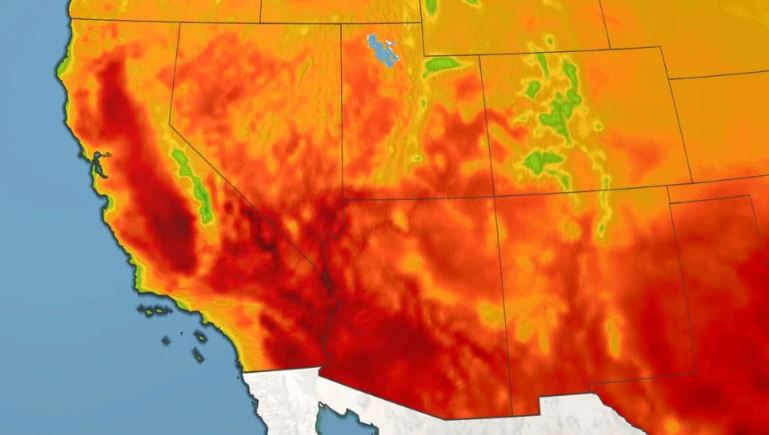Unprecedented Heat Dome Threatens Lives Across the U.S.
The United States is currently experiencing an unprecedented heatwave, with temperatures soaring to record highs across the Midwest and East Coast. A high-pressure weather system, known as a heat dome, is trapping sweltering temperatures, leading to dangerous conditions for many residents. This early onset of extreme heat, typically seen in late July or August, is now striking in June, posing significant health risks.
The Science Behind Heat Domes
Heat domes occur when a high-pressure system traps hot air over a region, preventing it from escaping. This phenomenon has caused temperatures to reach nearly 38°C (100°F) in numerous cities across the Midwest and East Coast. According to Benjamin Zaitchik, a climate scientist at Johns Hopkins University, this unusual early heatwave is a testament to the increasing frequency and intensity of heatwaves driven by climate change.
Early Heatwaves and Health Risks
The early arrival of such extreme temperatures can be more hazardous than heatwaves occurring later in the summer. Our bodies typically acclimatize to higher temperatures gradually, much like adjusting to a hot bath. Sudden spikes in temperature can catch people off guard, leading to a higher incidence of heat-related illnesses. Outdoor activities that are normally safe in June can become perilous under these conditions.
The Impact on Human Health
Extreme heat exerts tremendous stress on our bodies. It can lead to heat exhaustion, characterized by symptoms such as faintness, headache, and dizziness. If untreated, heat exhaustion can escalate to heat stroke, a life-threatening condition that can cause delirium, seizures, and even death. Prolonged exposure to high temperatures can strain various bodily systems, particularly the cardiovascular and renal systems.
Vulnerable Populations
Certain groups are more susceptible to heat-related illnesses. Older adults, particularly those over 65, are at higher risk because their bodies are less efficient at cooling down. Chronic conditions such as diabetes or heart disease exacerbate the risk. Pregnant women are also vulnerable as extreme heat can stress their cardiovascular systems and increase the likelihood of preterm births and low birth weights.
People with limited access to air conditioning, including the homeless and outdoor workers, face heightened dangers. Urban areas with limited green spaces and high humidity levels can exacerbate the heat’s effects, leading to higher risks in densely populated cities.
Adapting to Early Summer Heat
With climate change contributing to an increase in the frequency and severity of heatwaves, it is crucial to adapt our strategies for coping with extreme heat. Communities must develop robust plans to protect vulnerable populations. Ensuring that public spaces provide adequate shade and hydration, and that public transport runs efficiently to minimize wait times in the heat, are essential steps.
Community Involvement and Support
Community involvement is vital in adapting to these changes. Air conditioning, while effective, can be costly, and financial assistance programs may be necessary to help those in need. Checking on high-risk individuals, particularly those who live alone, can prevent heat-related fatalities. Collaborative efforts can ensure that solutions are both effective and equitable.
The Role of Climate Change
The intensification and early onset of heatwaves underscore the urgent need to address climate change. Changing atmospheric patterns and climate feedback loops are driving temperatures to unprecedented levels. As we move forward, understanding these patterns and developing comprehensive mitigation and adaptation strategies will be critical to safeguarding public health.
Conclusion
The current heat dome baking the United States is a stark reminder of the increasing dangers posed by climate change. As temperatures rise earlier and more intensely, the risk of heat-related illnesses and fatalities grows. It is imperative that we adapt our communities and infrastructure to better cope with these extreme conditions. Through collective action and robust planning, we can mitigate the impact of these dangerous heatwaves and protect the most vulnerable among us.
Summary Table:
| Key Learning Points | Details |
|---|---|
| Heat dome phenomenon | High-pressure system trapping hot air |
| Early and extreme heatwaves | Unprecedented temperatures in June |
| Health risks | Increased risk of heat exhaustion and heat stroke |
| Vulnerable populations | Older adults, pregnant women, outdoor workers, homeless |
| Community adaptation | Public shade, efficient transport, financial assistance |
| Climate change impact | Intensification of heatwaves, earlier onset |

Sunil Garnayak is an expert in Indian news with extensive knowledge of the nation’s political, social, and economic landscape and international relations. With years of experience in journalism, Sunil delivers in-depth analysis and accurate reporting that keeps readers informed about the latest developments in India. His commitment to factual accuracy and nuanced storytelling ensures that his articles provide valuable insights into the country’s most pressing issues.



